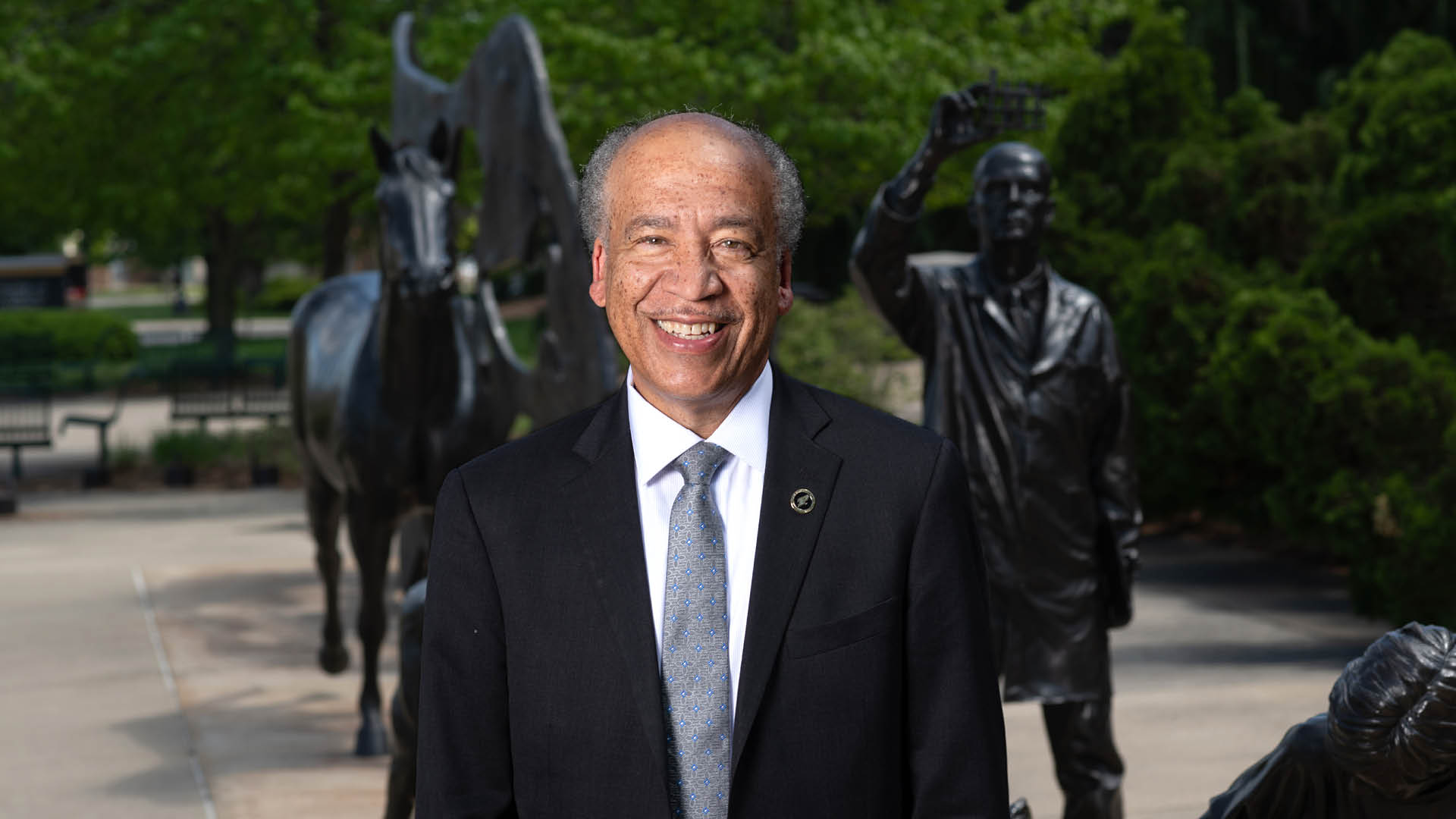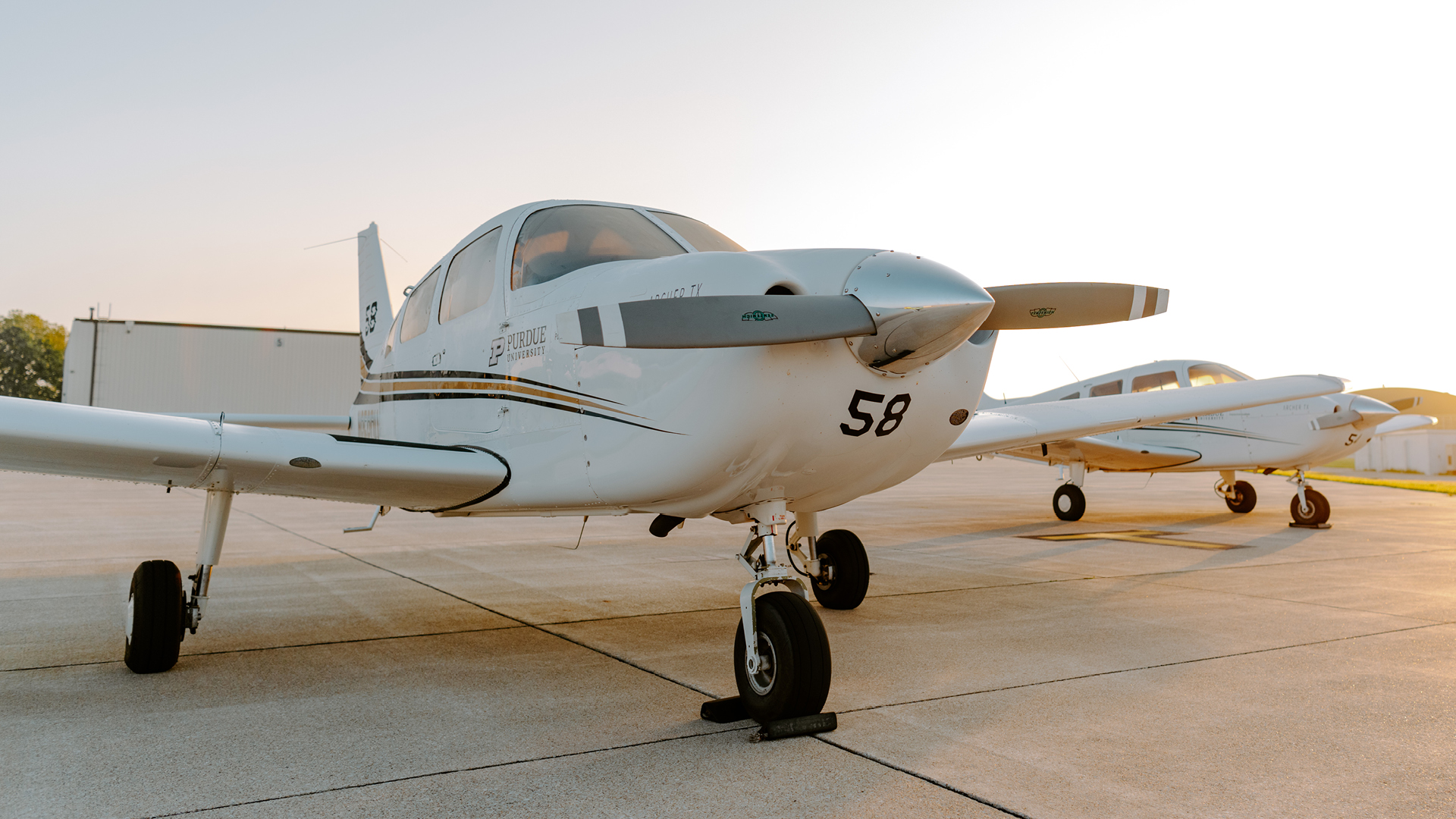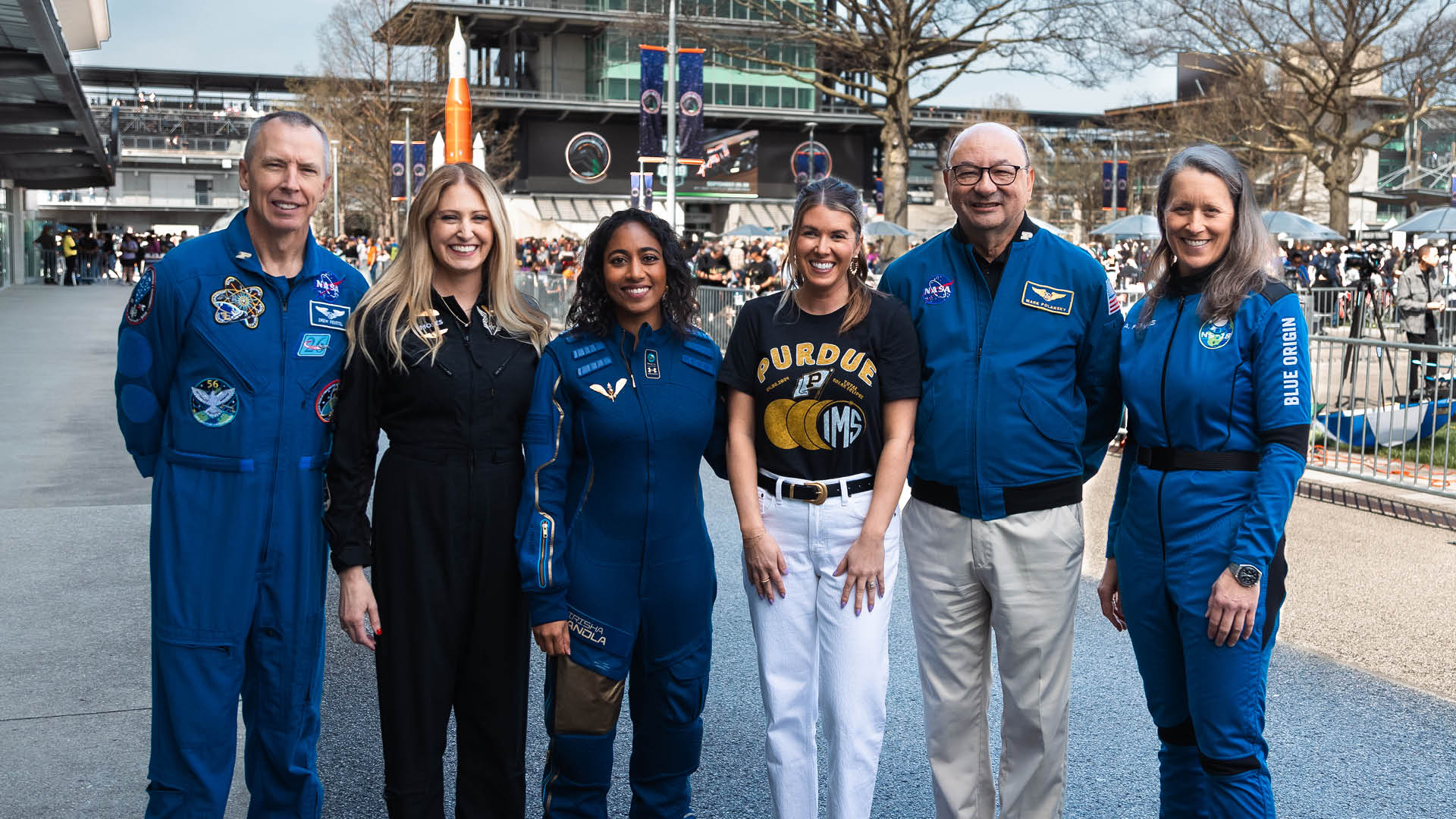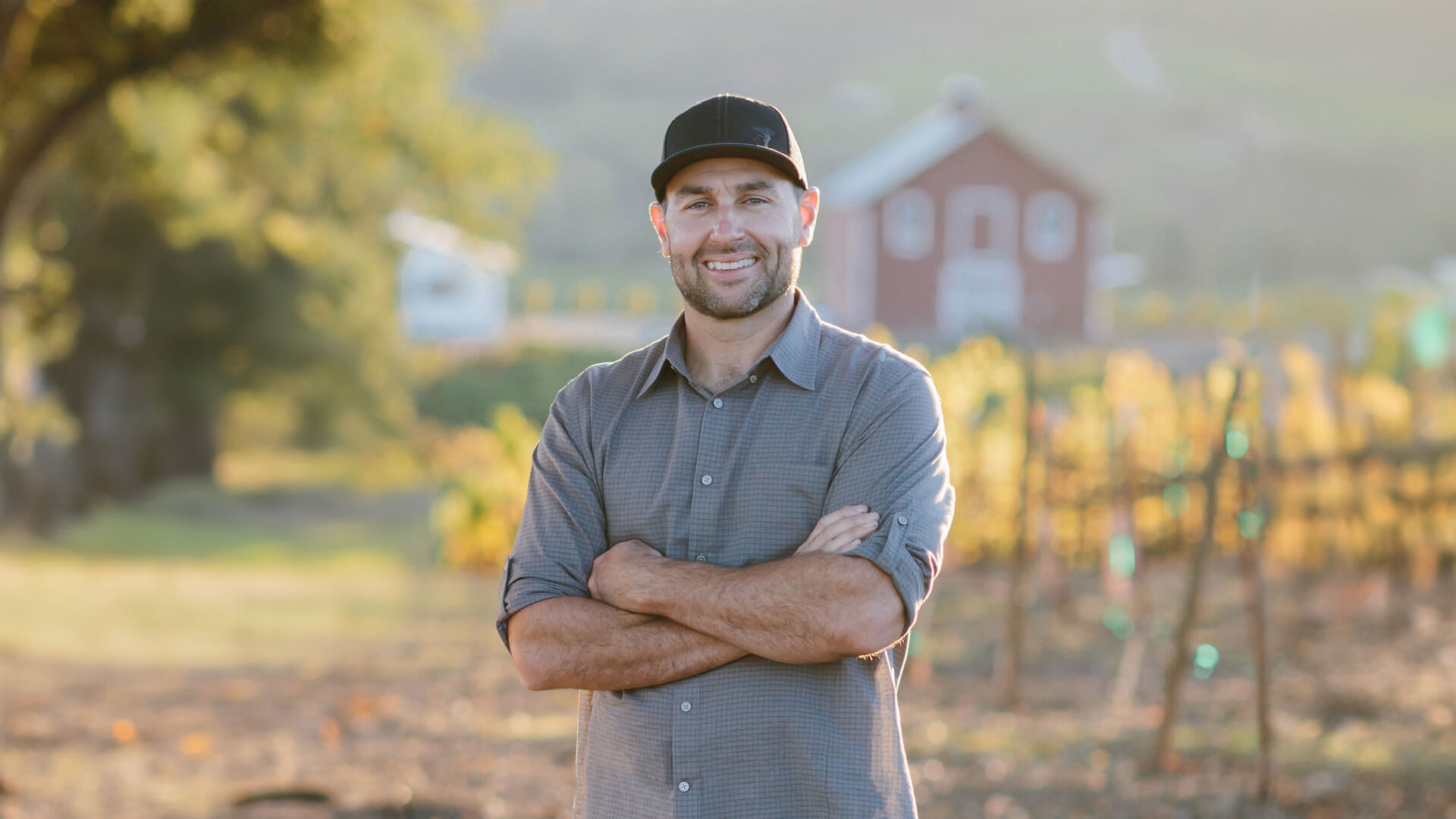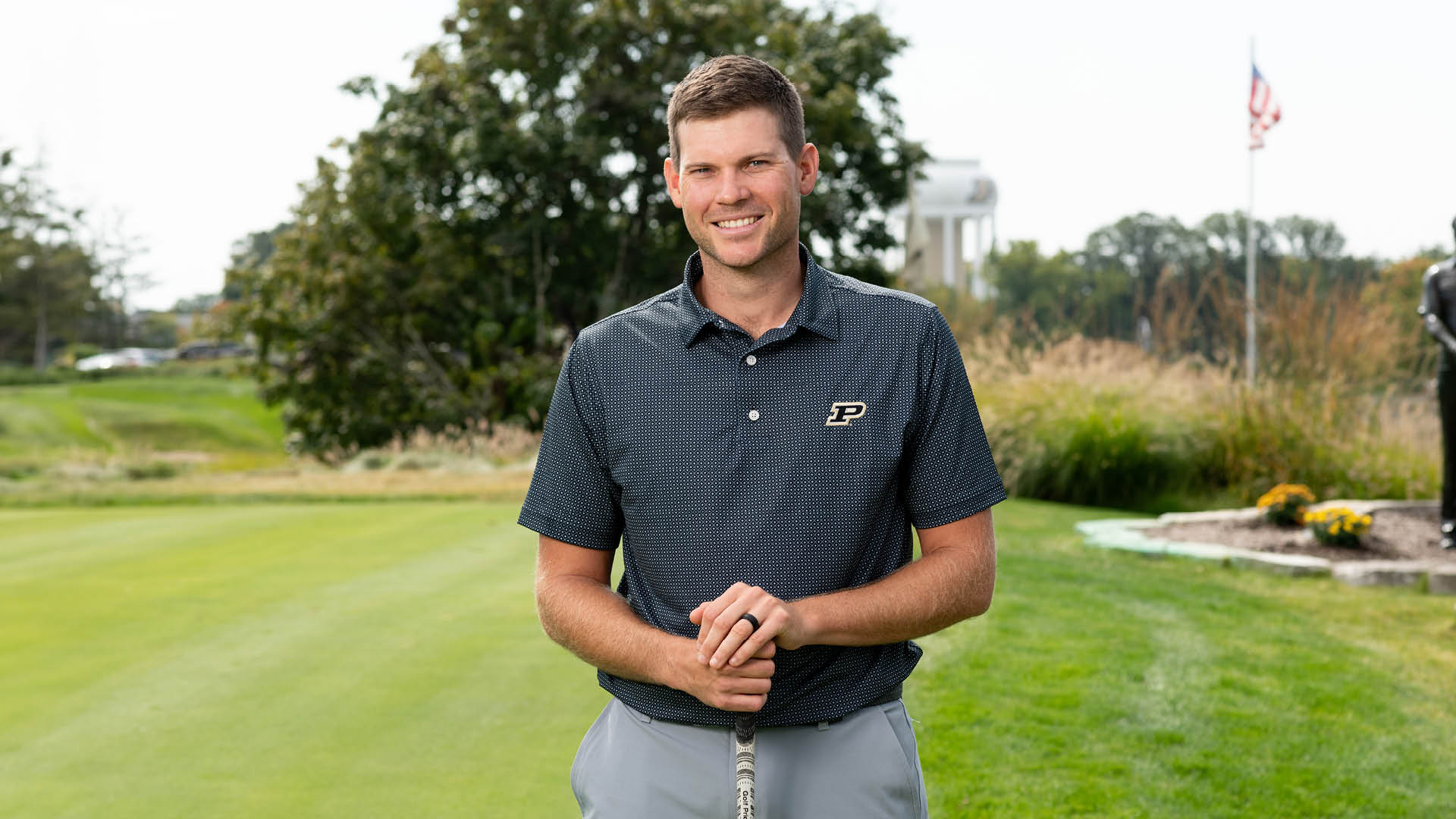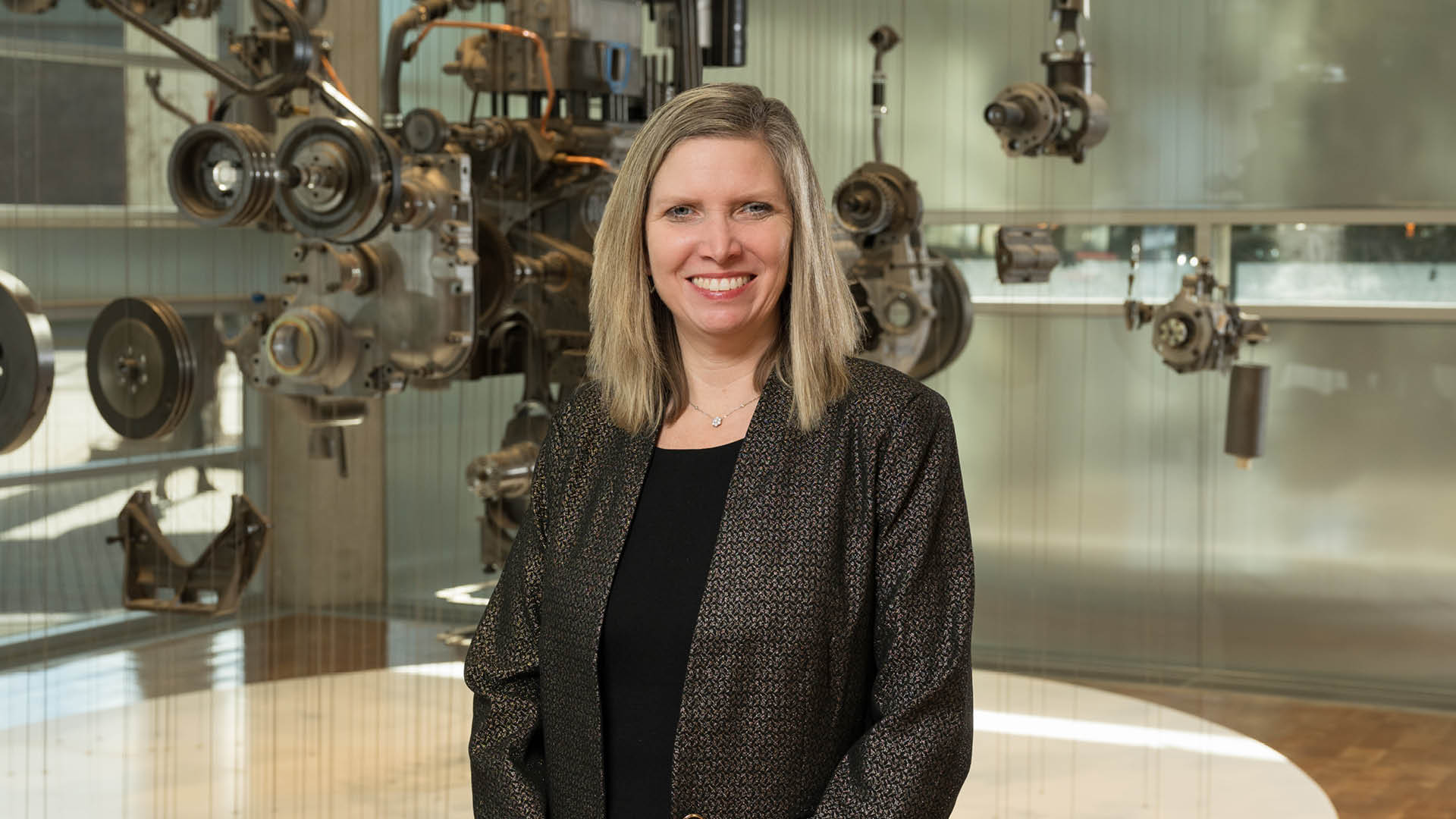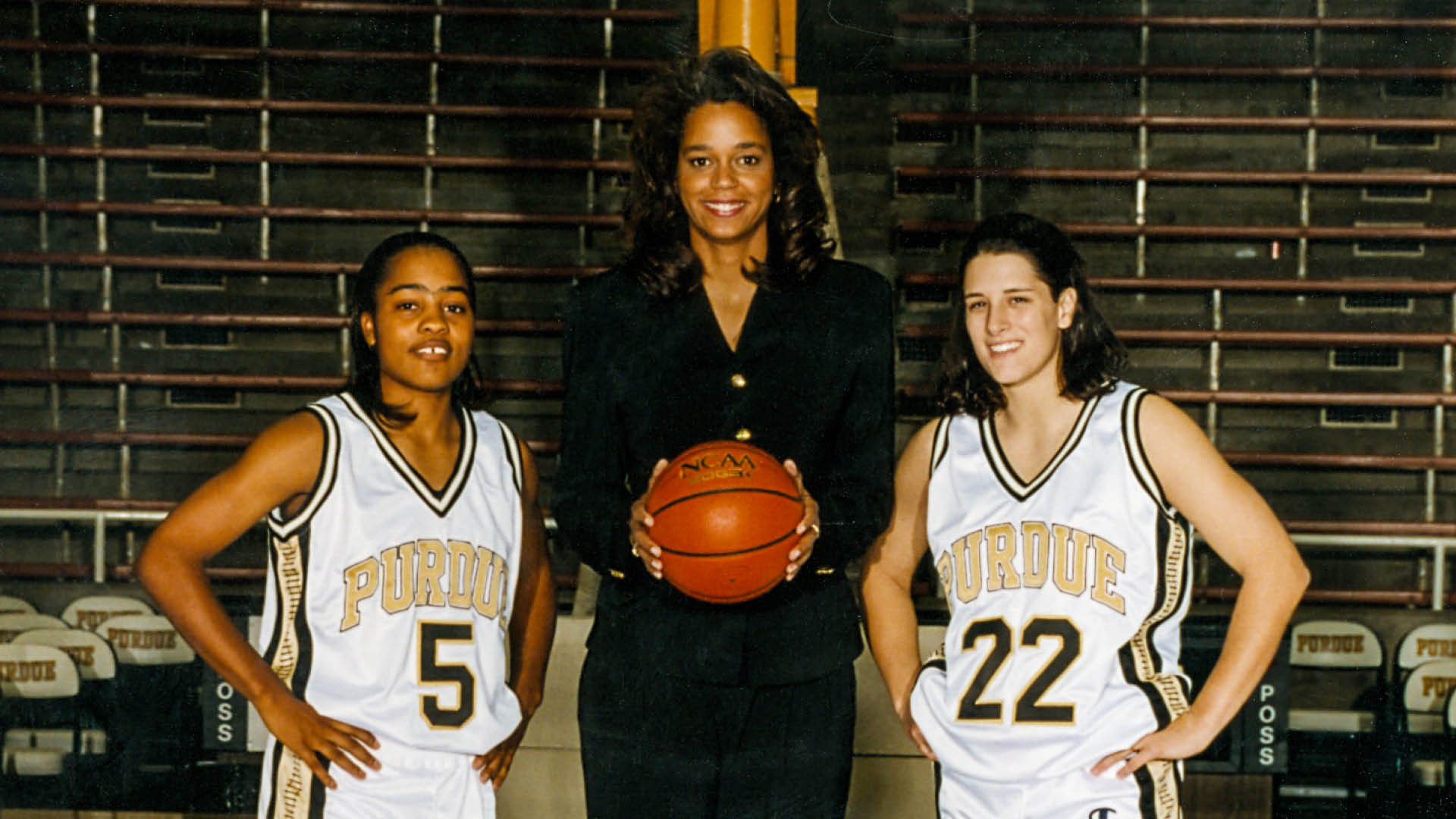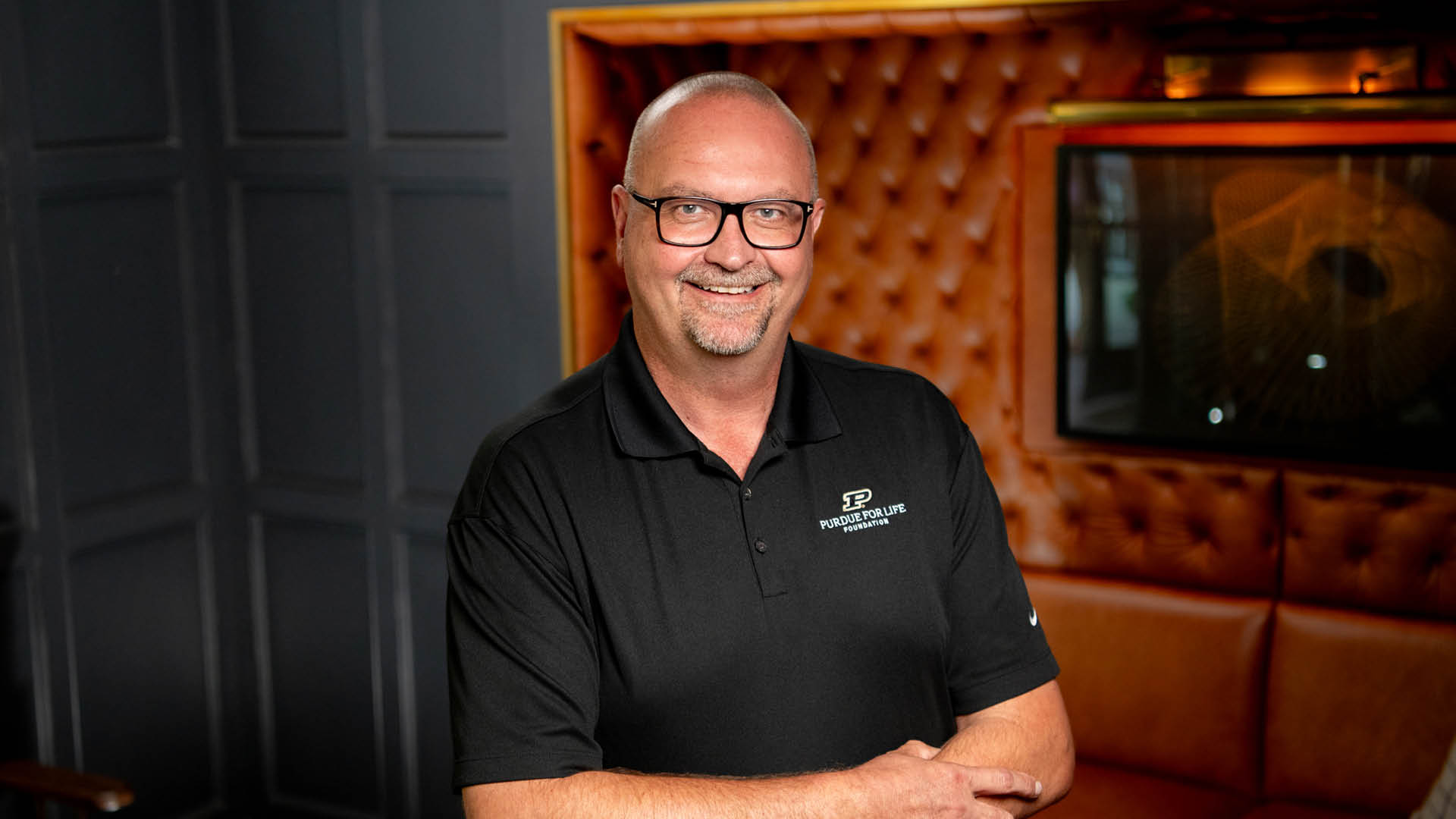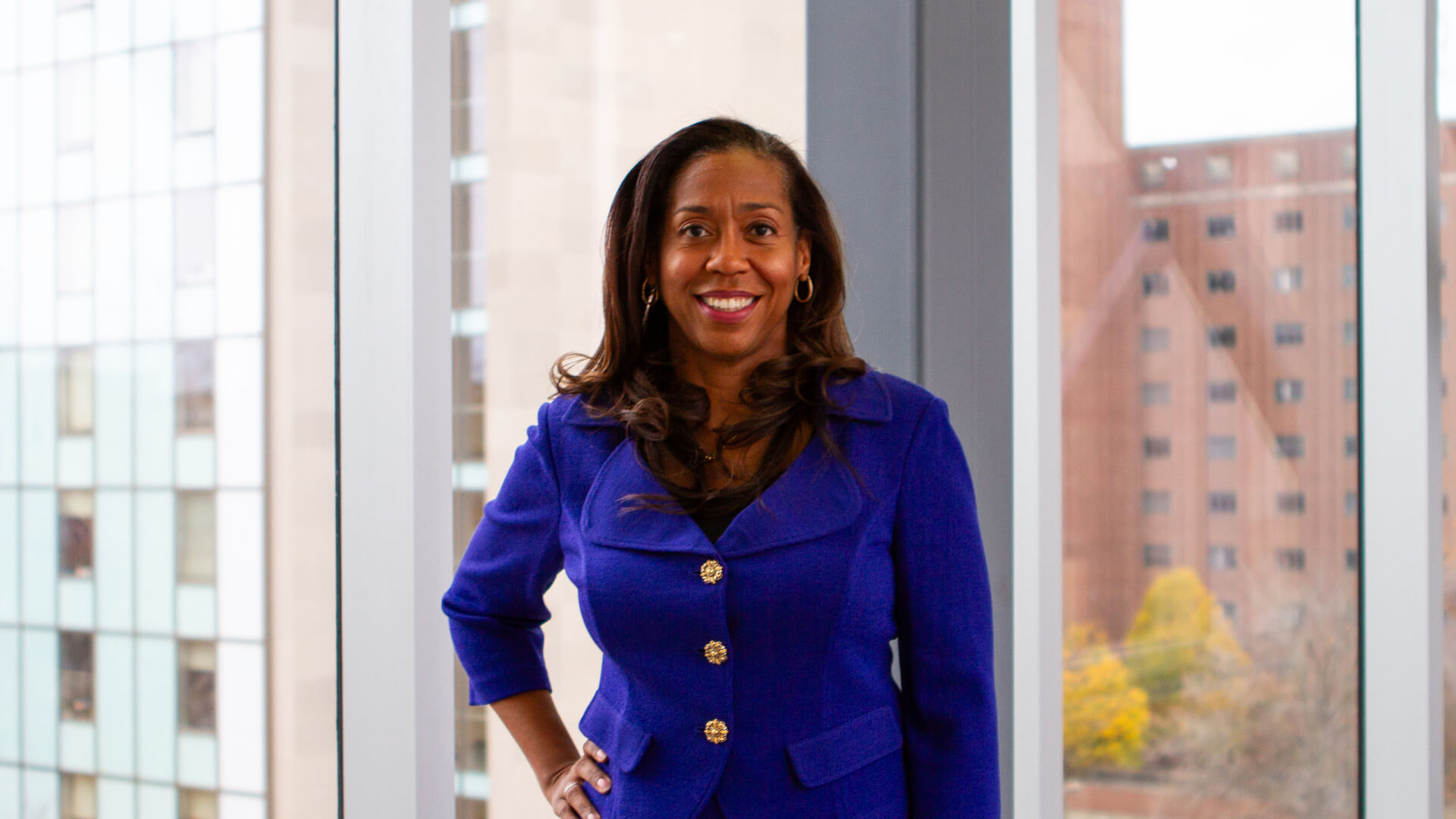Podcast Ep. 108: The Making of the Indy 500: Meet the Boilermakers Behind the Scenes of the Indianapolis Motor Speedway’s ‘Greatest Spectacle in Racing’
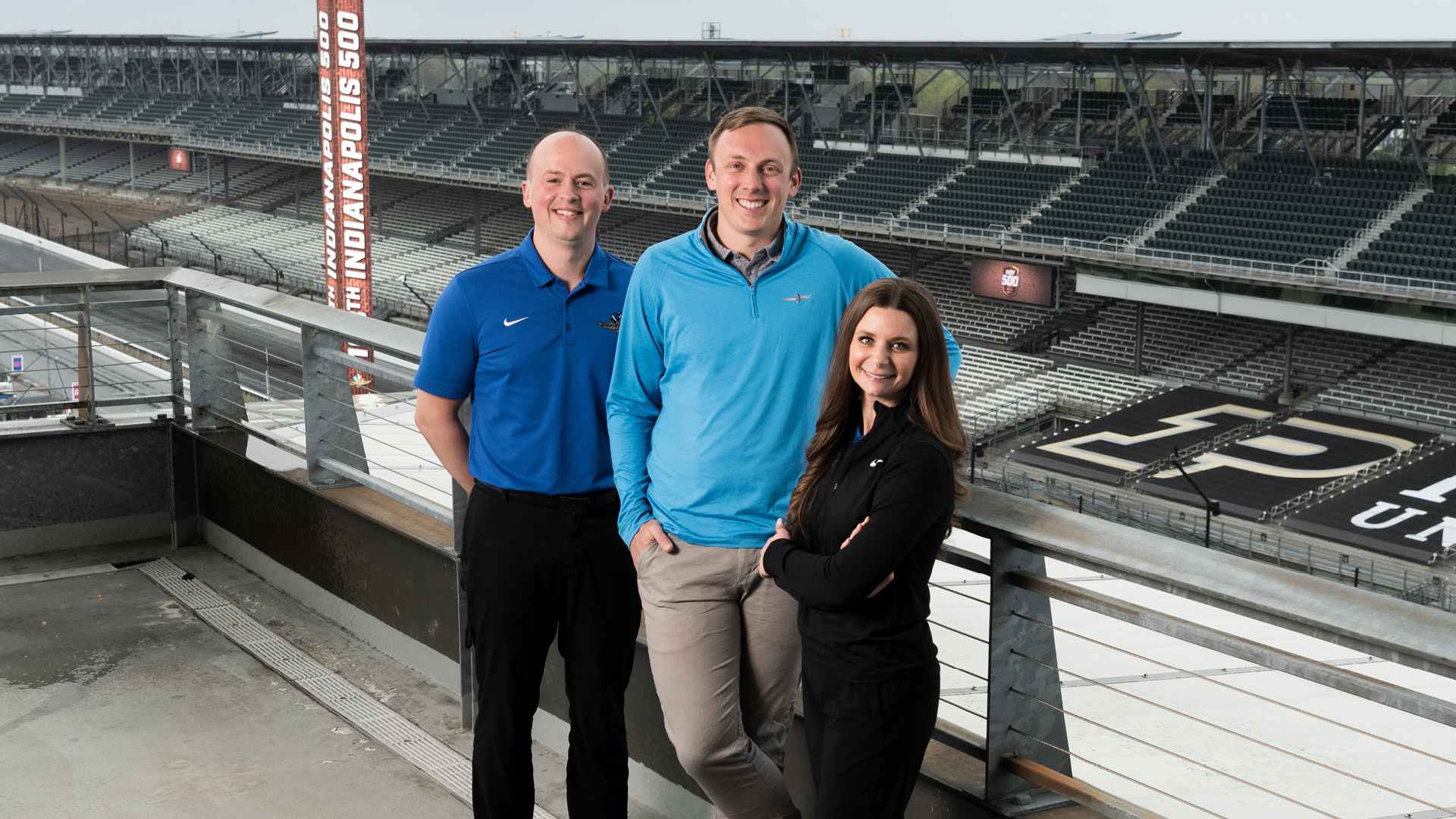
In this episode of “This Is Purdue,” we’re talking to three Boilermakers who work behind the scenes at the Indianapolis Motor Speedway to execute “The Greatest Spectacle in Racing” — the Indianapolis 500.
Listen as David Letherman (BS management ’15), senior manager of event personnel; Meredith Walker (BS management, marketing ’11), senior manager of VIP and talent experience; and Louis Kissinger (BS chemical engineering ’17), senior manager of events and administration, share how the problem-solving skills they learned during their time at Purdue prepared them to host hundreds of thousands of people at the iconic IMS.
Plus, you’ll hear behind-the-scenes stories on the infectious buzz surrounding the month of May in Indianapolis, can’t-miss Indy 500 events and the best spots to watch the race. They also look ahead to the future and discuss why Indy 500 attendance numbers are rising with new partnerships and explain more about the events intended to attract new audiences and enhance existing fans’ experience.
The IMS hosts more than 200 events each year, and David, Meredith and Louis have dedicated their careers to making sure every guest — race fan or not — has an unforgettable experience at this legendary venue.
Don’t miss this episode as these three Boilermakers go in-depth on what it takes — and how it feels — to pull off the largest single-day sporting event in the world.
- Learn more about Purdue’s mark on the Indianapolis 500
- Learn more about the Indianapolis 500
- Learn more about the Indianapolis Motor Speedway
- Learn more about the Mitchell E. Daniels, Jr. School of Business
- Learn more about the Davidson School of Chemical Engineering
Full Podcast Episode Transcript
David Letherman:
I’m David Letherman and you’re listening to This is Purdue.
Meredith Walker:
I’m Meredith Walker and you’re listening to This is Purdue.
Louis Kissinger:
I’m Louis Kissinger and you’re listening to This is Purdue.
Kate Young:
Hi, I’m Kate Young, and you are listening to This is Purdue, the official podcast for Purdue University. As a Purdue alum and Indiana native, I know firsthand about the family of students and professors who are in it together, persistently pursuing and relentlessly rethinking who are the next game changers, difference makers, ceiling breakers, innovators? Who are these Boilermakers? Join me as we feature students, faculty, and alumni taking small steps toward their giant leaps and inspiring others to do the same.
David Letherman:
I get a lot of intrinsic value out of working here and to know that this is a lot of people’s Christmas. I mean, this is Christmas Day to large majority of our race fans, that is just so cool to be a part of, and people see the wing and wheel and they say, Oh, you work at IMS. They have a story. They want to talk to you about it, and I enjoy that.
Kate Young:
It’s that time of year again, Boilermakers. For the past two years, during the month of May, our This is Purdue podcast team has interviewed Purdue IndyCar engineers who have gone on to win the Indianapolis 500 with their respective teams and drivers. You may remember in 2022 when Angela Ashmore made history as the first woman to win the Indianapolis 500 as a member of the winning cars crew with IndyCar Driver, Marcus Ericsson. And in 2023, we interviewed two team Penske IndyCar engineers, Matt Kuebel and Mike Koenig. They worked on all three team Penske IndyCar entries that raced in the 2023 Indianapolis 500, including Josef Newgarden, who won the 107th running of the Indy 500 last year. Now in this episode of This is Purdue, we’re switching it up a bit. We’re talking to three Boilermakers who work behind the scenes at the Indianapolis Motor Speedway to execute the greatest spectacle and racing, the Indianapolis 500.
That’s right. We’re giving fans special access to the iconic IMS in Indianapolis and bringing you all of the details on what it takes and how it feels to pull off the largest single-day sporting event in the world. In this episode, Boilermakers, David Letherman, Meredith Walker, and Louis Kissinger are sharing how their education and experiences at Purdue prepared them to host hundreds of thousands of people at more than 200 different events at the IMS each year. So drivers, start your engines. Let’s dig further into how Boilermakers continue to shape the Indy 500 year after year. Here’s my conversation with David, Meredith, and Louis.
Oh, and by the way, a quick note. We shot this interview at IMS during an Indy 500 open test day, so you may hear some Indy cars zooming around the track throughout our interview. Okay, let’s get to it.
Thank you all for joining us on. This is Purdue, Purdue’s official university podcast. We’re super excited to hear some behind the scenes stories from three Boilermakers who helped put on the Indianapolis 500. Iconic.
Meredith Walker:
Yes, thank you.
Kate Young:
We’re excited. So why don’t we go down the line, introduce yourself and your role at IMS and a little bit about your Purdue background.
David Letherman:
Sure, yeah. My name’s David Letherman. I’m the senior manager of event personnel here at IMS. I’m a 2015 Purdue graduate from the Daniels School of Business, where I have a marketing degree and then a minor in Spanish and an entrepreneurship certificate. So I’ve been here since 2015. I came to IMS through the Orr Fellowship, and I was actually IMS dispersed Orr fellow, so I worked under Allison Melangton for a little while around the 100th running of the 500 and now have transitioned into operations.
My primary duty is around the guest service staffing that works all of our events. So the iconic yellow shirts all work with our team, but also have several other areas where we pull staff from to make the events go. So staffing is a big piece, but also everything that goes with supporting the staff: so the bike rack, the cones, the uniforms, clocking in, clocking out, hiring, all that kind of stuff. So that kind of centers around our job too. Finally, on event days, I’m in our event command center working through operational problems and firefighting because the plane never survives first contact, so always trying to figure out how to make it work when things don’t go well. So that’s what I do.
Meredith Walker:
I am Meredith Walker. I’m a 2011 graduate from Purdue Daniels School of Business as well, with a major in management and a minor in marketing, and I had a little bit of a untraditional path in getting into the event space. Right after graduation from Purdue, I moved up to New York City and worked in the education sector. I worked for a charter management organization out there and did some recruitment, interviewing, and placing school teachers and school support staff in schools in Brooklyn and so I’m in New Jersey as well.
I moved back, I got engaged, moved back to Indianapolis in 2015, and spent some time once I moved back to Indie networking and meeting with folks within Indianapolis community and landed myself a position here at the Indianapolis Motor Speedway on our client services team, working with our suite and hospitality clients and overseeing our club spaces. And since then, I’ve moved into our VIP and talent experience role while I work with our VIP guests during event time and then dabble in the employee engagement side of things as well during non-event times. I grew up coming to the track and so I was familiar when I moved back to Indianapolis and thought this would be a cool place to work, and I’m so glad that I found myself a position in the event space because I feel like I will never not work events.
Kate Young:
So both of you the 100th running.
Meredith Walker:
Yes.
David Letherman:
Yes. It was our first event.
Meredith Walker:
I was thinking back to that, I’m like, it was such an awesome year to the start, but we didn’t know, I guess I didn’t know what to compare it to, so it was our first time, but it was really, really cool to see the community rally around this event, and it was our largest attended Indianapolis 500 to date, and hopefully this year we’ll be close second, if not more than, but yeah, it was really, really cool to be a part of that.
David Letherman:
Honestly, it’s more about ignorance is bliss. We had no idea what was actually happening, so we’d just figure it out.
Meredith Walker:
Exactly.
David Letherman:
Yeah.
Louis Kissinger:
And I’m Louis Kissinger. I’m a 2017 graduate of Purdue University. I did not go to the Daniels School of Business. I actually got a degree in chemical engineering, and because I was fortunate enough or unfortunate enough, sometimes I blame David for being here. Other times, I thank him every day for dragging me and getting me to apply to the Orr Fellowship, and that’s how I ended up here as well. So have been in a general events management event support role for the duration of my time here since 2017. But now I also oversee some special projects, including our concert area, so the three concerts that we put on during the month of May.
Kate Young:
So you talked a little bit about your Boilermaker journeys. When you were at Purdue, were you fond of racing? Did you go to the Indy 500 every year? What was your relationship with the IMS and IndyCar at that point?
David Letherman:
I had never been to the race before. Honestly, when I got my degree from the Daniels School of Business, it was more of just kind of a scattershot thing, like I can do a lot with this, but I didn’t have a plan when I entered my senior year except that I knew the fellowship was an option. And so I joined the fellowship, and at finalist day of the fellowship, IMS was one of the host companies, and I just ended up making a connection with the people there and ended up here. So IMS was not even close to on my radar graduating from Purdue.
Meredith Walker:
And as I mentioned, I grew up coming to the 500. Both on my mom and dad’s side of the family, big racing fans and have had tickets for 50 plus years. I will say growing up, I was more coming for the social aspect and working on my tan in turn four, but I’ve grown such an appreciation for the sport. So the venue is familiar to me and what it meant to our city, and state, and the world, but certainly have such a greater appreciation for the sport, and the venue, and the people that work here and put in so much hard work day in and day out after having become an employee here.
Louis Kissinger:
I had been to two Indy 500s, so I’ve now been to nine in a row. Growing up, I was always a big sports fan, knew of the Indy 500 but didn’t really understand the scale or scope. Honestly, my first interaction was my mom watching Dancing with the Stars and seeing Hélio Castroneves win the Mirror Ball Trophy. So IndyCar, the entity IndyCar Series, and IMS weren’t on my radar at all. Obviously, with my degree, I didn’t think I was going to be doing anything else other than being an engineer. So luck kind of has its way, and now I’m so excited to be here almost every day.
Kate Young:
So speaking of scale and scope of the Indianapolis 500, what is these behind-the-scenes stories and putting together this event? There’s diehard race fans listening to this, watching this. What would they be surprised to know about each of your roles when it comes to that big day?
David Letherman:
There’s so much behind the scenes that goes on that guests don’t see. We start planning for the 500 in January, and pretty much all of January through April is getting ready for the month of May. In the guest experience perspective, it takes 1,800 people just to do guest services roles on race day, and we have to do that in a variety of different ways. Yellow shirts being the biggest, and safety patrol being the biggest influencer in that. But we get here at one in the morning on race day, and we don’t go home until 8:00 P.M. on race day. And honestly, it’s just a lot of little things coming together to make it all work.
Kate Young:
And I know IMS has had this culture of volunteerism. What would fans be surprised to know that some things are run actually by volunteers versus actual employees of IMS?
David Letherman:
Most of our staff are actually employees. The yellow shirts are IMS College program, our W-II-paid employees, and we have about 800 of them. We also partner with some area organizations, 501(c)(3)s, to come out and raise money. So that’s the volunteers that would kind of tie into that. But it does take many people, and most of our yellow shirts have been here for longer than I’ve been alive. Our average age is in the 60s, so it’s very much more like a Kiwanis club, or a Lions club, or a Rotary club, a fraternal organization, than it is a job. The yellow shirts are a unique organization, and it’s really special when you have the same safety patrol work in the same section every year, and they’ve made relationships with the same fans who have those renewed tickets, and everybody has their yellow shirt, their safety patrol. We really want to capitalize on that as a part of the culture of being at IMS.
Louis Kissinger:
I think something that surprises me about the safety control too is the number of people who have worked at Eli Lilly their whole lives or have owned companies and do this as a passion project because they do care so much about it. It’s not just your hourly worker who’s coming out to try and make some cash. It’s these people who truly care about this place and want to make it better, which is why typically our scores are pretty good in our post-event surveys.
David Letherman:
I mean, our customer service continues to grow and that’s because of people like the safety patrol and other people that work here that just put on a great experience.
Kate Young:
And then, Meredith, with your role, you have the VIPs. What is the process like deciding who’s going to wave the green flag, who’s going to sing the national anthem, what all goes into that?
Meredith Walker:
Yeah. So I work closely with our VP of corporate communication, Alex Damron, and he sort of is on the front end of securing that talent, working with our executive leadership team and media affiliates like NBC to figure out who we’re going to plug into those honorary roles like Green Flag, National Anthem, so on and so forth. So Alex and I partner, and once we’ve secured that talent, it comes to me to handle all the logistics and execution from that point on. I think something that when people say VIPs and celebrities, that can easily sound very glamorous.
I think if I’ve done my job well, by race weekend I’m not entertaining or with any sort of VIP or celebrity we’ve secured, we have staff who will help, handlers for the weekend, and then that way I’m free and floating to troubleshoot as necessary. But mine, I think people are often, who’s the coolest celebrity or VIP you’ve met? And it’s don’t get me wrong, I do get to do that in my job, but a lot of it’s behind the scenes, like most of our jobs are. And it’s hugely focused on attention to detail, and it’s things like securing ground transportation, and private jets, and commercial flights, and specific catering requests. And it’s a lot more on the logistics and operational side of things than it is more of the entertainment and forward-facing piece.
David Letherman:
And I think that’s a common thread that you could pull between all three of us is we want to be bored on event days.
Meredith Walker:
Yes.
David Letherman:
If we’re not bored on event days, then we’ve missed something or I mean there are always going to be problems, but if we’re bored on event days, that means we did the pre-work well and then everything’s going as planned.
Kate Young:
That is super interesting and it makes sense though, all the prep work and you know you’re over prepared for event day.
Louis Kissinger:
It’s really hard too because you’re sitting, I’m up on David, I’m Pagoda Nine and your adrenaline’s pumping. You want to be helping, but all of the things that you can do to help have already been done. That’s something that we’ve all learned from Allison, who we worked with closely is if you’re not doing anything, it’s because you’re doing the right thing, so it’s good.
Kate Young:
And then Louis, with your role, events are live, things happen, and it’s kind of like also though we talked about this with the recent Solar Eclipse viewing event, I thought everything was amazing and it went off without a hitch, and that’s what you want people to think, even if inside you’re a little bit nervous or stressed, right?
Louis Kissinger:
Yeah. So, I mean, live events, you only really get one shot at it, and with something like the Solar Eclipse or the Indy 500, that’s the hardest part about the job is there’s no test run. We don’t get another chance at an Indy 500 for 360 something days. The expectations and the pressure to be perfect are so high, but if we’ve done our job right, nine out of 10 we feel really good about it, but know that there were things that we missed on an Indy 500 race day, and the fans feel a 10 out of 10.
If that kind of comes together, most of the stuff that we are worried about is nitpicky things that we want to be better at because we’re perfectionists and we expect the best out of the people who come and work and view at the Indianapolis Motor Speedway. So my wife gets very frustrated with me when I go to other events because I’m like, Oh, why is that sign there? Well, that doesn’t make any sense. What’s this staff person doing? So those types of things just become a part of who you are, and I love going to other live sporting events and enjoying as a fan. So it’s a great marriage of my job and my passion.
Kate Young:
But are you secretly analyzing all these other professional sports?
Louis Kissinger:
Yeah, I just don’t get to verbalize it. So, no. I mean, most places do a really good job and they’re doing exactly the same things we’re doing. We just have to do it at six times the people right of anybody else.
Kate Young:
Now, as many Boilermakers know, Purdue continues to have a mark on the Indy 500 each and every year, from the all-American marching band performing across the yard of bricks to Purdue-trained engineers in the pits, preparing IndyCar drivers for the 500-mile race. Purdue has helped welcome fans back home again to Indiana for more than 100 years. And over time, Boilermakers’ enthusiasm and involvement in the sport has only grown from the pre-race parade to the stories you’re hearing now on the behind-the-scenes event planning involved in pulling off the greatest spectacle in racing. David, Meredith, and Louis share more about what it means to them to work for the Indianapolis Motor Speedway and specifically to ensure the Indy 500 is planned to perfection.
This event means so much to the city, the state, the country, the world, the racing community. What does it mean to you all that you get to contribute to this success each and every year?
David Letherman:
I get a lot of intrinsic value out of working at IMS. I mean, there’s a little bit of pride having the wing and wheel. I think if you talk to most people in this company, the wing and wheel means a lot, but we talk about events, and it’s a little bit like a drug. You kind of crave it. You want that chaos, and the people who are really good at events thrive in the chaos, love the chaos.
Kate Young:
I was going to say it takes a special person though, and all three of you, I can tell.
Meredith Walker:
Yeah.
David Letherman:
Yeah. Because easy to lose your head. It’s easy to get overwhelmed with the details of the moment, but this will be my 10th May-
Meredith Walker:
Mine too, yeah.
David Letherman:
Similar for you. And every year you learn a little bit of something else, but I get a lot of intrinsic value out of working here and to know that this is a lot of people’s Christmas. I mean, this is Christmas Day to a large majority of our race fans, and that is so cool to be a part of, and people see the wing and wheel and they say, Oh, you work at IMS? They have a story, they want to talk to you about it. And I enjoy that.
Meredith Walker:
I echo everything that David just said, and I think I get more excited on Race day than I do for Christmas. So I think it is such an honor to work here, and like David mentioned, to have a bit of pride in wearing or a lot of pride in wearing the wing and wheel. I know for myself, there’s such a deep sense of loyalty and commitment after working here. I think not only to this place, but to the fans and the relationships we’ve built, but especially my coworkers. People come and go, and we’ve certainly had changes over the years, but the team of people that we work with is by far, I mean, we were working weird hours, late nights, early mornings, and weekends, and I think the commitment that I feel to those people is beyond, and I think it is such an awesome feeling to accomplish, to be a small part of the success in pulling this event off, but to share that alongside of my coworkers who I think of as an extension of my family.
David Letherman:
It is a different feeling, right?
Meredith Walker:
Absolutely.
David Letherman:
… than you working in a corporate setting. There’s a lot of shared hardship that we go through. Like you said, long hours. Just at the solar eclipse, we had the IT team, the creative team, the facilities team, all at a gate scanning tickets because we are so busy and so it’s a unique culture.
Meredith Walker:
Yeah, and we’re growing up together. We were just talking before this, I was at both of these guys’ weddings and it’s cool to have that close-knit staff culture that we have here.
David Letherman:
Yeah.
Kate Young:
I can tell the camaraderie, I mean, just you all walked in. Yeah, yeah.
Louis Kissinger:
You go to battle with these people, and you have to trust them implicitly. All the planning for months and months and months from June of one year to May of the next, you’re talking about the Indy 500 and how to make it better. And on the day of, you just have to trust that everything is going to go to plan or as close as possible because you have good decision-makers and people out there who you can trust to, in the moment, not lose their heads, to talk through a problem with somebody, make a phone call if they’re truly in trouble.
Oftentimes, the best part of our day is at the end we all get together a few hours after the race and we have a drink and celebrate together, and just hear some of the wild stories or the fan interactions and just, oh my gosh, can you believe that so-and-so won? Or that crash was crazy. So just getting to enjoy and bask in the glow of that is awesome. Having this wing and wheel on your chest, it’s a very prideful thing for me, but it’s a responsibility. I mean, people take this so seriously sometimes to a level that I’ve never understood before, but they take it very seriously. And so we have to do the same to make sure that they have the experience that we can provide and they expect.
Kate Young:
And when it comes to the diehard race fans, that’s one thing, but how do you all work to appeal to maybe some non-race fans or people who haven’t been to the IMS before?
Louis Kissinger:
The snake pit is one-way. So for good or for bad, we host about 20,000 people who typically don’t even necessarily understand that there’s a race going on out in that area. So the hope is, and we’ve seen it throughout the years, is that those ticket customers convert to general admission ticket customers and then ultimately convert to our reserve seats. So that’s one way that we’re trying to engage the younger community in what we do out here. But I think we’ve put a huge emphasis on since the 100th running, honestly, in our engaging the arts community, Jimmy McMillian and our DEI initiatives have taken a huge step forward in the last three or four years post-COVID. Just trying to get people to come to the track and understand that, hey, you may not care about the racing, but there’s so many other things that go on out here or people that are involved. We have a whole PR team, we have a marketing team, creative, you can do anything and work in racing. You don’t have to drive the car, you don’t have to work on the car.
Kate Young:
Or be a super big sports fan.
Louis Kissinger:
Not at all. Yeah, there are people who probably couldn’t tell you who won last year’s race that worked in our office.
Kate Young:
I could see that.
Louis Kissinger:
But that’s okay. They want to be a part of something special, and that’s how we get people to come out here and understand that this is a special place. You just have to make your own memories.
Kate Young:
Absolutely.
David Letherman:
And we’re not, I mean, we are a racetrack, but we also have facilities to do a lot of other things. So we host probably 200 events a year that are not related to the racetrack, so dinners and all those kinds of things. During COVID, we were a vaccination site, so we opened the doors and we helped vaccinate over 100,000 people during COVID as kind of a drive-through clinic. The solar eclipse event was an awesome way for us to get some people in here. 80% of those ticket buyers had never been to IMS before, so I think our leadership does a great job of opening the doors to this place to more than just a race car.
Meredith Walker:
Absolutely. Yeah. I’ll just echo what both them just said. I think, and it’s exciting to think about down the road what events we can continue to attract. Obviously, we have the space here, we can do a lot with it. And so, I think it’ll be cool to see what new events and different audiences that we will continue to bring here.
Kate Young:
Yeah. And even when we had a lot of news, national news outlets broadcasting from here, it is such an iconic special place with all this history even if you’re not a sports fan, or race fan.
David Letherman:
I mean, most people don’t understand how big it is. You hear two and a half-mile oval, but you don’t really get it until you see two and a half miles. That’s a long way. Our facility is 988 acres, 230,000 permanent seats that most people can’t fathom what that would even look like.
Louis Kissinger:
Four holes of a golf course.
David Letherman:
Four inside the oval.
Louis Kissinger:
Just inside.
David Letherman:
Just inside the oval. So when I bring new people here, they’re most in awe of the fact that just how big this place is.
Meredith Walker:
Absolutely.
Kate Young:
As the Indy 500 and IndyCar Series popularity has grown throughout the years, the month of May is no longer just about celebrating the coveted race at the end of the month. It’s an entire month-long celebration, especially in Indianapolis. Aside from attending the Indy 500, these three Boilermakers detail other activities and events they recommend checking out during the month of May.
Meredith Walker:
We all experience it here in Indianapolis and hopefully beyond that too, but there’s such a buzz. Once our ticket office, once the doors are open and people are coming in to pick up their tickets and credentials and we’ve got people out on property loading in, the buzz in the air is so infectious and it just gets everyone excited for what’s to come the rest of the month of May. Those are the 10 most treasured days for me during the year. It’s like you don’t want them to end. You want them to continue, and for the next day not to come because you don’t want it to be one closer day to when it’s culminating. I think it’s so much fun to experience the event high that we all get during the month of May and all of the community members who kind of lean into that as well downtown, especially here on Main Street. I think Main Street’s done a great job of leaning into that and it’s active throughout the entire month of May and really fun place to frequent as well.
David Letherman:
And we are open for 12 days throughout the month. We have two races, two concerts. My second favorite day outside of race day is pole day. I mean, I think pole day is a lot of fun because, and it’ll be again this year, there’s a driver, sometimes a well-known driver, who won’t make the field for the 500, and that just excitement, anticipation. I love Sunday of qualifying and fun.
Louis Kissinger:
And we saw it last year. Yeah, they honor and respect the tradition of that. There’s certainly ways that you could go around being out of the race and just on the face of it, their values say, no, we can’t do that. We’re not going to.
David Letherman:
And Graham Rahal was heartbroken.
Louis Kissinger:
Oh, yeah.
David Letherman:
That was a really hard for him last year, him being a household name and being part owner in a team and it’s Indy, it doesn’t play favorites, and I just think that plays into the month of May too.
Louis Kissinger:
Our sales team will tell you the month of May really starts on the first warm of spring because everybody starts picking up the phone and calls and says, How do we get here? How do we book this? How do we show up and be a part of this special month? So they love it because the first day, and then especially once it’s the first day, we get cars going around the oval. We have fans out in Turn two, everybody starts to just feel that excitement. So the buzz is already picking up, and that is what kind of pushes us through the hardest part of the preparation that we’re about to go through.
Kate Young:
David, Meredith, and Louis share their recommendations and personal favorites when it comes to the May festivities, you can participate in.
David Letherman:
So many different things. I mean, as Meredith had said too, the Indianapolis Arts Council has done a lot of things with the arts community, 500 Fashion Fridays at the Keystone Fashion Mall. I would just, if you want an experience of May buy in, do some of the stuff that we have to offer, put out a checkered flag like most people do in the city, come to more events than just race day.
Meredith Walker:
Yeah, I was going to say the 11 other days that we’re open are a great opportunity. Of course, we want everyone to come and experience the 500, the bucket list item, but I think all the other days that we’re open, the track activity is great and are lots of fun, and provide a different feel than the Indianapolis 500 does. So I think encouraging people to come out on the other days that we’re open as well. And then, I think, just leaning into the ways that the community rallies and community partners activate and rally behind us I think would be awesome.
Louis Kissinger:
Yeah, I mean, the first Fridays at the Harrison Center downtown is a great one that IMS is involved in and just gets people together, host a porch party. You just have friends over and have a lemonade and dinner, and you can just feel the excitement. So it doesn’t need to be coming to the track, right? Ideally, yeah, we want everybody to be here, but being a part of Indy 500 is being a part of Indianapolis, and so if you’re here, you’re already in it. So buy in.
David Letherman:
Buy in.
Meredith Walker:
Yeah, I’m all in on the fashion Fridays. My wardrobe is like half blue polos, half checkered print, so I think yeah, definitely. We’ve seen, that’s been a really cool thing that we’ve leaned into is encouraging people to dress in their 500 fashion attire, and I’ve worked with some local shops around here and have really seen some return on that, so it’s really cool.
Kate Young:
As for their Purdue journeys and experiences, these three Boilermakers discuss how their time at Purdue teed them up for success in their careers at the IMS.
Looking back at your time at Purdue, how did your Boilermaker experience prepare you for all your roles that are very different, but you had that Purdue education, and especially, Louis, how do you go from chemical engineering to this massive event planning?
Louis Kissinger:
Yeah, I mean, I think everybody, when they go to be an engineer, there’s obviously a certain set of hard skills that you have. You don’t try to become an engineer if you aren’t interested or proficient in math and science. That kind of comes with the territory. I think what I felt during my time at Purdue and during involvement in both working in intramural sports at the CoRec and being involved in Purdue Dance Marathon was I was gaining a lot of other skills. A lot of the soft skills that I am really proud of and have used on a daily basis today were things that I learned at Purdue and was able to develop from my freshman year to my senior year. I don’t think I would’ve recognized that person, but the one thing that has been the same through since probably before Purdue is I’m a problem solver.
That’s what I want to do every day, and that’s what makes me super excited. If you throw something at me, I want to break it down and put it back together. Now, chemical engineering is not necessarily that, but here at IMS there are such complex problems, whether it’s because of the number of things that we have to do or the number of people that have to be involved in what we do. And so being able to pull that apart strand by strand and really get everybody on the same page and moving forward is one, is the core of what’s at my job and why I’m so excited to be here.
Meredith Walker:
He is definitely our go-to for all the complex math and science. And during the pandemic, he was the go-to for all the figures we put together.
Louis Kissinger:
That was a mess and it was fun.
Meredith Walker:
The engineering degree helps tremendously.
Louis Kissinger:
And I’m unique in this field, right? So that’s another thing that, selfishly, I take a little bit of pride in. Not many people have my background who work with us at the track or with our other groups who come in. So it’s fun to be able to provide a different perspective.
Meredith Walker:
I’d build on what he said. I think the problem solving and the critical thinking skills, and then, of course, working in groups and different teams, I think that the skills that you develop and acquire in working with groups and group settings help a lot and transfer into the workplace. But like Louis, I think we all crave the problems that exist, and then we can go and solve. So I think my time at Purdue definitely helped with that. And then the critical thinking piece.
David Letherman:
Same as what these guys said, but also I took a lot of advantage of my time at Purdue. I was involved in Intramural Sports, which is how Louis and I kind of got to know each other. As a Purdue student government, I was an RA in Harrison my senior year, and so I think a lot of it had to do with time management and being able to, because pretty, I mean, I did not feel constrained at all at Purdue with doing what I wanted to try and do. So the amount of opportunity that I saw and was able to take advantage of was awesome. So time management was a big piece, and in my role specifically, helping develop some of those soft skills on how to deal with people. And in my job, you have to have hard conversations about setting standards and maintaining standards, and I feel like Purdue just really sets a high standard. And so I think that that helped me a lot too is what a high standard looks like and how to maintain that.
Kate Young:
David, Meredith, and Louis share what they’re looking forward to most when it comes to the future and the growth of large events like the Indy 500 at the IMS.
David Letherman:
It’s a really exciting time to be in IndyCar and at the Indianapolis Motor Speedway. The place is alive again. People have the passion. We’re gaining new fans. I just saw a post that somebody came to the Eclipse and they bought tickets and camping today, and so they love this place so much, thought was so cool, and we’re building new fans every day, and I think it’s a really exciting time to be a part of both organizations.
Meredith Walker:
Absolutely. I think we all have been here since before the Penske acquisition, and I think it’s been really cool to experience that change in leadership and see the changes and improvements that have been made to the facility itself and throughout the organization. But I’m excited to continue to see where and how we develop the facility and then what events that allows us to attract. I think in my previous role, working with the suite and hospitality spaces, I think I always like those type of projects where we see a space when we look to update it or what can we change this into. So excited to see what might be possible down the road there. But yeah, excited to continue to attract new audiences, but keep our returning fan coming back. So I think, like David, we’re excited to continue to grow the events that we host here at the Speedway but also continue to grow the IndyCar sport as well.
Louis Kissinger:
Yeah, I think it’s kind of like Purdue, right? Isn’t there a written or unwritten rule that Purdue has to be ever-changing? It has to be adapting, right? It feels that way around IMS right now, whether it’s putting the new IMS performance center out in turn three, whether it’s we have a new food and beverage partner, and they’re investing a ton of money to try and make the fan experience better. So it’s those small things that we are really putting our time and effort into to improve Indy 500 Race Day. But in general, we have so many other racing events. We have so many other racing series from around the world who want to be here because of the history of what we do. And then, also because our team is so good at what we do, our renewal rate on these track rentals and all these other things that happen throughout the year is incredibly high.
You can hardly get a date here because people want to come back year over year over year. So for me, seeing the growth of the NTT IndyCar Series feeds us all these new fans, and people want to come here, and in turn we help pour that back into them and help, a lot of our staff are now going on the road to help them, and they’re stepping in to help us with all the national media you’ve been referencing, right? All of that stuff, we’re just really building off of each other, and that relationship has been stronger than ever, which I think just opens the doors to a lot in the next five, 10 years.
Kate Young:
I love that tie Louis made between the IMS and Purdue’s persistence and innovation. Now I promised a behind-the-scenes look into this iconic race, and it wouldn’t be as special This is Purdue Indy 500 podcast episode without some rapid-fire questions. Okay. So what question do these three get the most from fans when it comes to working on producing the Indy 500? What are their favorite race-day traditions? And oh, here’s one that is sure to cause some discussion. What is the best spot in the IMS to watch the race? David, Meredith, and Louis share their answers. Okay, so all of our race fans, we want to know the behind-the-scenes details. Tell us the number one question you get asked when it comes to working for the IMS and working on the Indianapolis 500.Crazily enough, the question I get asked is, Oh, are you busy on race day? Do you actually work that day? Yes, yes. I worked very hard that day, I promise.
Meredith Walker:
I think similarly, what do you do outside of the month of May? The events in May or what do you do the other 364 days of the year? I think people underestimate the planning that goes into leading up to the month of May and all of our events here at the track.
David Letherman:
I’d say the most popular question I get asked is, who’s the most famous person you’ve met? And I don’t meet famous people.
Kate Young:
You’re kind of busy that day.
David Letherman:
Yeah, I’m not a celebrity handler. I’m moving bike rack. I’m placing staff, I’m not meeting famous people.
Kate Young:
I love it. A behind the scenes look at the non-glamorous part.
Meredith Walker:
[inaudible 00:32:52].
David Letherman:
Yeah.
Kate Young:
Okay. What’s your favorite tradition at the Indianapolis 500?
David Letherman:
I love all pre-race, but Taps is my favorite.
Meredith Walker:
Also, pre-race. I think that listening, hopefully being out on the grid and listening to the national anthem and then watching the flyover is just a surreal experience.
Louis Kissinger:
I really think the roar of the crowd as the drivers come around the final time and 11 rows of three and everyone’s all rooting for the exact same thing at that time is really special.
Kate Young:
There’s a lot of debate over the best spot to watch the Indianapolis 500. I need to hear from each of you your opinion on the best spot.
David Letherman:
Honestly, to me, there isn’t a debate.
Kate Young:
Oh, damn it.
David Letherman:
Turn one up high in E Penthouse is by far the best place to watch. You can’t really buy those seats on race day because those are renewed for forever, but turn one up high, I think, is such an iconic view of the Pagoda, and you can see from the short shoot in the north to all the way through turn two. So I think it’s oval turn one.
Meredith Walker:
I’m team turn four all the way. My family, as I mentioned, has had tickets in the same area for 50 plus years, and so every race day after the green flag has been waved, and I try to sneak out there for five to 10 minutes, usually wolf down a piece of fried chicken, and since I’ve eaten nothing until that point, and say hi to my family and then soak in the vantage point from turn four. So I’m biased because that’s where my family sits, but there’s really not a bad seat in the house. I will say we get to be in a lot of different areas, and I think often people are trying to get into the sweet spaces and all of that, but our grandstand seating provides some awesome, awesome views, and exactly, you see more of the racing than you do potentially in a sweet space. So I think it’s cool that each family or individual who comes has their favorite seat, and they stick to that. So I’m team turn four.
Louis Kissinger:
Look, if you’re trying to watch the racing, I think that’s fine, but the real fun part is getting to watch the people.
Meredith Walker:
That’s the true, very true.
Louis Kissinger:
So if you want to see the best people watching, you go to turn three on the viewing mounds, and you just sit back and relax because you’ll see something you probably have never seen before.
Meredith Walker:
Right.
Louis Kissinger:
Avoid the mud pits.
Meredith Walker:
It happens.
Louis Kissinger:
It’s what it is.
David Letherman:
It is its own culture.
Meredith Walker:
Yes. Yeah.
David Letherman:
It’d be curious what Louis would say actually.
Louis Kissinger:
I mean the best spot is where we get to watch from Pagoda nine, but nobody can get there, right?
Meredith Walker:
True.
Louis Kissinger:
We have a very special access, which I don’t take for granted for sure.
Kate Young:
I love that all three of them had very different answers, and all three of them thought they had the right answer there. As we mentioned earlier, the IMS hosts more than 200 events each year, and David, Meredith, and Louis have dedicated their careers to making sure every guest race fan or not has an unforgettable experience at this legendary venue. These three Boilermakers share their most memorable special moments when it comes to working for the IMS.
David Letherman:
The first one that comes to my mind is COVID and how that all kind of played out because we were on such pins and needles with what this place was going to look like in COVID. We thought we were going to have the race in May, and then we found out three weeks before that we couldn’t. And then it was half our staff got furloughed, and then it was figure out how to do it all together, and that was really hard. But also, all three of us continued to work, and we were a part of some of that team that helped continue to keep moving things forward. That was a really emotional and uncertain time for all of us, not just at IMS, but for the world. And so I think when people ask me, what’s one thing that you continue to remember? It was being a vaccination site that we helped through COVID, and it was the 135,000 people who were here for the 2021 race and how weird that was, and being on the grid for the 2020 race when no one was here.
And that just was so surreal. So unlike what normal race day feels like, but also it brought a lot of people, our team, together, it brought a lot of people back in 2022, that was a really emotional race; it was 2022. It was the Back Home Again messaging, and it was people coming back to the place that everybody loves so much. I think that whole progression from the uncertainty of COVID to the half measure we had in 2021 to what 2022 felt like, and having everybody here again and then everything that went in between all that I think was super impactful for me.
Meredith Walker:
I’m trying to think of one specific memory. I wish I could just bottle up the way that May feels like a perfume and spray it on me when I needed a little bit of it. I think that it’s all those small moments. I can think of requests that I’ve made. To race day morning, Find some Raisin Bran, and I’m like, Of all things Raisin Bran, and it needed to be somewhere immediately. I’m trying to juggle 500 other things. But I think little things like that are all, and laughable moments that you look back on, it seems like the biggest challenge or hurdle at the time, but you look back on it and you’re like, it’s just a blip in time and something that we laugh about for years to come.
And I think there’s nothing that beats, obviously, it’s sad after the race concludes because it’s kind of like a let-down for us. We prepare and prepare and prepare, and then it’s, yes, we’re relieved, but it’s this sadness that comes with having completed that year’s race. But just the pride that we feel in having pulled off the greatest spectacle in racing with people we care so deeply about, I think, is just such a cool experience. And just looking around at people I trust and care so deeply for. I think that, to me, at the culmination of the race is such a special memory that I hold every year.
David Letherman:
I think it is kind of hard to come up with a single thing.
Meredith Walker:
Exactly.
David Letherman:
Because there’s so many individual moments, and some of them in the moment, you’re like, What the heck? What just happened? But then you have another one, or just, I think it’s kind of hard to come up with a single moment.
Kate Young:
That makes sense.
Meredith Walker:
Exactly. And things are flying so rapid speed that it is just like you might not even have time to stop and think about how crazy the request was or how funny it was. And so I think that it all comes together and gives us that event high that we all enjoy and crave.
Louis Kissinger:
Yeah, I mean, some of the most special interactions. I still remember, I think it was during a Brickyard, some kid came up to David and wanted a checkered-pinned button on his lanyard. It’s like, Yeah. And that kid had the best day probably because of it, right? The smallest little thing that you can do to make a fan’s day, and you have no idea, right? Now, in a different vein. My welcome to Indianapolis moment was the first year I was here full time, I was responsible for our glamping area. It was crazy hot that year, and I had ordered the same amount of ice that we’ve ordered for three or four years before that. Well, it’s Saturday morning, and we’re out of ice. And me being new, I’m like, Well, we’re out of ice.
Well, I’ll call and get more ice tonight. Well, of course, that’s not an acceptable answer. So I’m calling our food beverage provider. I’m calling everybody. So we find a little bit of ice. Well, that night, it’s 9:00 P.M. Saturday night before the race. We just put on the Legends Day concert at this point, and I am loading a golf cart with our executive team interns, me, whoever was around, is loading ice into a golf cart so that this group of 500 fans can have ice for race day. And that, in and of itself, one, never going to run out of ice anywhere, ever again. Two, it just speaks to the type of people that we need and crave at this place and why it’s so special to work with this group of people because, from the highest to the lowest, we were all doing the exact same thing 12 hours before we opened our gates.
Meredith Walker:
That reminds me of we hosted event here a couple of years ago called Lights at the Brickyard. And in coming, we had an activation in the plaza where there were fires, and we burned real firewood. And more than once, I was driving from my home to the Home Depot in Speedway and picking up rick. Is that what they’re called? Rick. It’s a firewood, and putting firewood in the back of my trunk and then bringing it over to the Speedway. So I think it takes a special type of person and someone who’s willing to kind of go all hands on deck and do whatever it is that the job requires to kind of make that event what it is for our customers.
David Letherman:
You jogged my memory on something.
Louis Kissinger:
Is this you? Is this the Ferris wheel or is this something else?
David Letherman:
No, that was different. I’ll talk about that. In 2018, we had the BC39, which is our dirt track race. We built a dirt track up in turn three. It was the first year or second year that we had it, and it’s a night race, so the gates open at 4:00 PM, they’re open until 10 P.M. And again, this is first or second year that we had the race, and we did not put in the request to turn off the sprinklers in some of our parking lots.
These are big sprinklers. They’re high-pressure sprinklers to get large areas of grass. Well, we had parked cars near these sprinklers, and these cars were just getting just beat up by these high-pressure sprinklers. I, and a couple other people were chasing these sprinklers with blue trash cans to try and put them over the sprinklers, so they stopped hitting the cars. We got soaking wet. I think it rained that night anyway, so I don’t know why the sprinklers were on. But I mean, stuff like that, I never think that I’d be chasing sprinklers around.
Meredith Walker:
And we always joke, in the event space, you will always, always, no matter what position or leadership position you’re in, move tables and chairs. That is just like a given in the event sector. You’re just going to be moving furniture or bike racks. We like to move bike rack as well. Yeah, so.
Kate Young:
I love it.
Well, we can’t thank you all enough. So exciting to hear some behind the scenes stories. Anything else you want to share with our listeners?
David Letherman:
I’m super grateful to be asked to do this.
Meredith Walker:
Absolutely.
David Letherman:
Being such a proud boiler and glad to be here at IMS, and this is pretty cool.
Meredith Walker:
Yes. Thank you so much for asking us, and certainly want to invite everybody to buy a ticket to the Indianapolis 500 if they haven’t already, or come join us for any day in May or our other events that we host throughout the course of the year.
Louis Kissinger:
Yeah, no, thank you so much. We’re all, as we said, very behind the scenes people. So fun to get out in front of the camera and tell a little bit of our stories.
Kate Young:
This year’s 108th running of the Indianapolis 500 presented by Gainbridge is on Sunday, May 26th, 2024. We wish this special IMS team all the best on race day. And by the way, have you ever wondered where celebrities like Adam Driver, Matt Damon, and Christian Bale sit while they’re watching the Indy 500? Join us on our podcast YouTube page for a behind-the-scenes tour of a VIP suite at the IMS. Just head over to YouTube.com/@thisispurdue. You can also check out our video with Michael Kaltenmark, head of marketing at IMS, to hear more about why the partnership between Purdue University and the IMS is so unique, especially when it comes to events like the recent Total Solar Eclipse viewing event and the Indianapolis 500. And be sure to follow This is Purdue on Apple Podcasts, Spotify, or wherever you get your podcasts.
This is Purdue is hosted and written by me, Kate Yang. Our podcast videography for this episode was led by Ted Schellenberger, Thad Boone, and Zach Mogensen. Our social media marketing is led by Maria Welch. Our podcast distribution strategy is led by Theresa Walker and Carly Eastman. Our podcast design is led by Caitlin Freville. Our podcast photography is led by John Underwood. Our podcast team, project manager is Rain Gu. Our podcast YouTube Promotions is managed by Kierstin Bauman. Additional writing assistance is led by Sophie Ritz. And additional assistance for this episode was led by Ashlee Shroyer and Dalani Young.
Thanks for listening to This is Purdue. For more information on this episode, visit our website at purdue.edu/podcast. There, you can head over to your favorite podcast app to subscribe and leave us a review. And as always, Boiler up.
